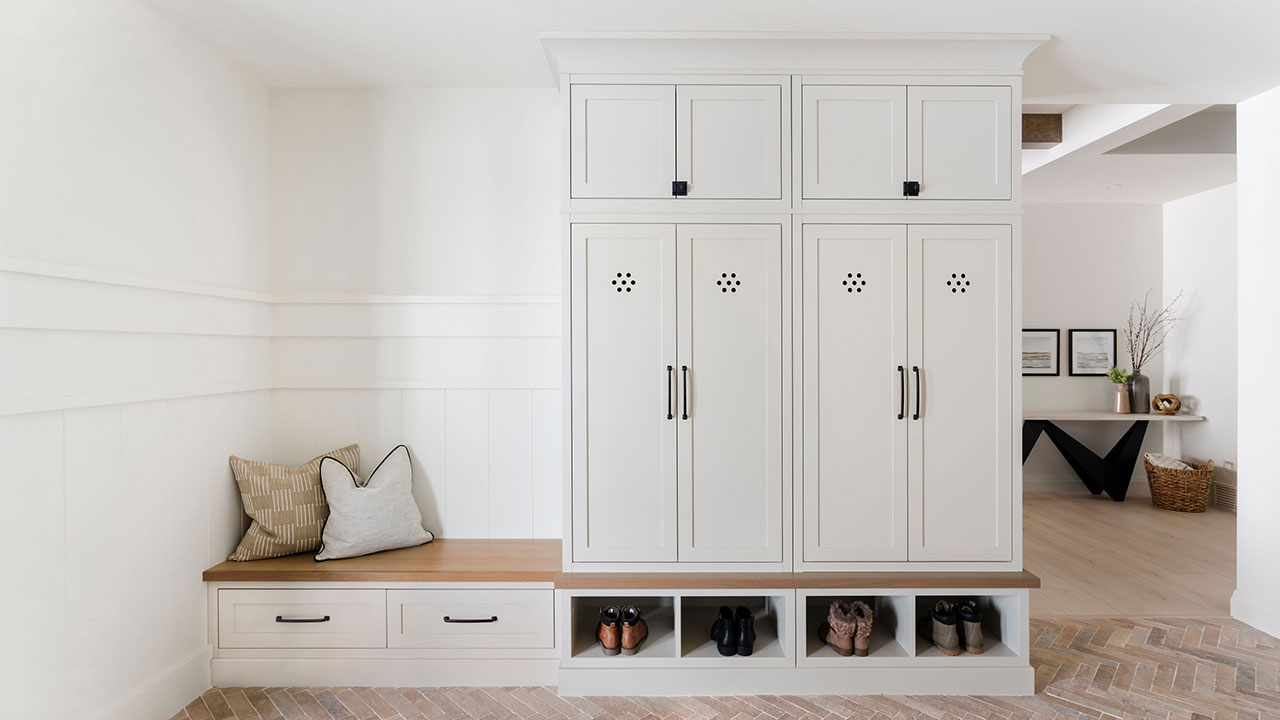Table of Contents
ToggleWhat Is a Mudroom?
A Mudroom is a secondary entrance to your home, typically located off the kitchen, garage, or back door. It serves as a buffer zone between the outdoors and your living space. Think of it as a mini-lobby for your house—complete with storage, seating, and organizational features that make daily routines smoother.
Why Every Home Needs a Mudroom
Whether you live with pets, kids, or just a busy lifestyle, a mudroom simplifies home management by:
-
Keeping dirt and moisture out of main living areas
-
Providing a centralized location for coats, bags, shoes, and keys
-
Reducing clutter in entryways and hallways
-
Adding resale value to your home
-
Supporting a more organized daily routine
Key Components of a Functional Mudroom
A well-designed mudroom combines practicality with design appeal. Here are the essential elements you should consider:
Storage Solutions
-
Cubbies & Lockers: Perfect for families, cubbies help divide space and reduce confusion.
-
Hooks & Hangers: Keep coats and bags off the floor.
-
Cabinets or Shelves: Store seasonal items, sports gear, or cleaning supplies.
Seating Areas
A built-in bench or simple stool allows you to comfortably put on or remove shoes. Some designs incorporate lift-up lids to provide hidden storage beneath the seat.
Flooring Options
Mudrooms take a beating, so durable, water-resistant flooring is a must. Top options include:
-
Tile: Easy to clean and available in various styles.
-
Vinyl Planks: Affordable, waterproof, and comfortable underfoot.
-
Brick or Stone: Rustic and durable but may require sealing.
Mudroom Design Ideas for Every Home
No matter your space or style, there’s a mudroom layout that can work for you.
Small Space Mudroom Hacks
Don’t have an entire room? Convert a hallway nook or closet into a mini-mudroom. Use vertical storage, slim benches, and wall-mounted hooks to maximize functionality.
Farmhouse Style Mudrooms
Incorporate shiplap walls, rustic wood accents, and vintage-style lighting. Add wire baskets or woven bins for an earthy, functional feel.
Modern and Minimalist Mudrooms
Go sleek with hidden storage, matte finishes, and neutral colors. Use clean lines and minimal decor to emphasize function and simplicity.
Mudroom Maintenance Tips
To keep your mudroom functional and welcoming:
-
Sweep and mop regularly to remove dirt and debris.
-
Wipe down surfaces like benches, hooks, and shelves.
-
Rotate seasonal items to prevent overcrowding.
-
Use baskets and bins to keep things sorted and hidden.
DIY vs. Professional Installation
Thinking of building your own mudroom? Here’s how the options compare:
| Option | Pros | Cons |
|---|---|---|
| DIY | Cost-effective, customizable | Requires time, tools, and skill |
| Professional | High-quality finish, efficient | More expensive, limited flexibility |
If you’re adding plumbing, electrical, or structural elements, hiring a pro is often the smarter choice.
Cost of Creating a Mudroom
The cost of a mudroom varies based on size, materials, and whether you DIY or hire professionals. Here’s a rough breakdown:
| Mudroom Type | Estimated Cost |
|---|---|
| Small nook conversion | $500 – $2,000 |
| Medium-sized room | $3,000 – $8,000 |
| High-end custom build | $10,000+ |
Pro tip: Modular and pre-built units can help cut costs without sacrificing style.
Common Mistakes to Avoid
-
Skipping a Floor Drain (in snowy or rainy areas)
-
Underestimating Storage Needs
-
Poor Lighting Choices
-
Choosing Hard-to-Clean Surfaces
-
Not Ventilating the Space Properly
Avoiding these pitfalls ensures a mudroom that’s both functional and enjoyable for years to come.
FAQs About Mudrooms
1. What’s the difference between a mudroom and a foyer?
A foyer is the main entryway, often more formal. A mudroom is utilitarian, designed to contain mess and organize everyday items.
2. Can I turn a laundry room into a mudroom?
Yes! Combining a laundry area with a mudroom is a popular space-saving solution, especially in smaller homes.
3. How much space do I need for a mudroom?
You can create a functional mudroom in as little as 3–4 feet of wall space. Larger rooms offer more amenities but aren’t necessary.
4. Should a mudroom be heated?
Yes, especially in colder climates. Heated floors or vents can keep the space comfortable and help dry out wet shoes and coats.
5. What colors work best in a mudroom?
Neutral tones like beige, grey, and navy hide dirt well. Bright colors can also energize a small space.
6. Is a mudroom a good investment?
Absolutely. Not only does it improve daily life, but it also adds resale value and appeal to potential buyers.
Conclusion
A mudroom may seem like a luxury, but in reality, it’s one of the most practical additions you can make to your home. From reducing clutter to creating a welcoming first impression, this small space offers big benefits. Whether you’re starting from scratch or upgrading an existing area, designing a mudroom that reflects your lifestyle and aesthetic can bring lasting joy and functionality.


